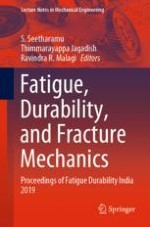This book presents selected papers presented during Fatigue Durability India 2019. The contents of this volume discuss advances in the field of fatigue, durability, and fracture, and cover mechanical failure and its applications. The chapters cover a wide spectrum of topics, including design, engineering, testing and computational evaluation of the components or systems for fatigue, durability, and fracture mechanics. The contents of this book will appeal not only to academic researchers, but also to design engineers, failure analysts, maintenance engineers, certification personnel, and R&D professionals involved in a wide variety of industries.
